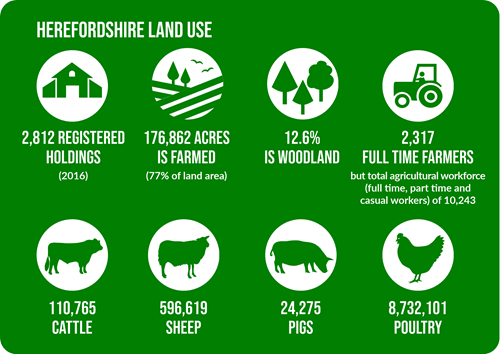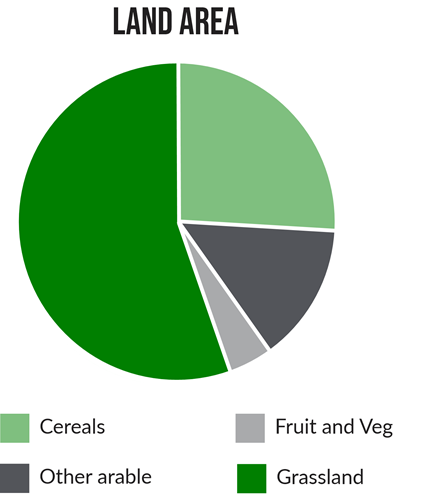Farming and land use challenges and solutions
The challenges
Agriculture and land use account for 12% of the UK's greenhouse gas emissions - with agriculture currently responsible for 10% of those emissionsEmissions are any release of gases.. Most agricultural emissions are from methaneA greenhouse gas that absorbs 84 times more heat than CO2. Approximately 60% of methane emissions are caused by human activity. from livestock and nitrous oxides, mainly from soils.
Herefordshire is considered to be the West Midlands' most rural county.

Source: DEFRA, 2016
Land use in Herefordshire
Of the total land used for agriculture and land use in Herefordshire, over half is grassland; over a quarter is cereal crops; about 30% other arable and about 10% fruit and vegetables.

Herefordshire has substantial numbers of livestock, therefore, managing grazing and livestock systems will be a key component in reducing greenhouse gasA gas in the atmosphere, such as carbon dioxide, methane, and ozone that absorbs solar heat reflected by the surface of the Earth, warming the atmosphere. emissions.
Damage to farmland soils costs around £1 billion a year in the UK and sediment loss has led to increased phosphate loadingHigh phosphate and nitrate levels cause eutrophication. This is when too much nutrient in a water body cause excessive growth of algae and other plants, which then affect water quality and damages plants and animals. in the Rivers Wye and Lugg within Herefordshire, both designated as Special Areas of Conservation.
Maintaining high quality farmed landscapes carries costs to farm businesses even when agri-environment funding is considered. Between now and 2030 the way farming land is managed will mainly be determined by how local farm businesses react to national legislation, regulation and support.
The solution
As a rural county we have a huge opportunity to manage the land responsibly to limit the impact of the climate and ecological emergency on people and wildlife by capturing carbon in the soil, hedges, grassland and trees while also reducing the footprint of food production.
There are significant opportunities to capture and store carbon from the atmosphere and provide other benefits for people and wildlife, while:
- Continuing food production, producing sustainable energy crops, a sustainable water supply and providing flood mitigation and erosion control
- Creating resilient ecosystems that help restore and rebuild wildlife populations
- Providing high quality green spaces and landscapes for people
A focus on farm productivity, input and fuel use together with biodiversityAll the different kinds of life you'll find in one area. Includes the variety of animals, plants, fungi and microorganisms. enhancements will help the county meet its net zero targets.
There is some uncertainty with two national bills going through parliament (new Agriculture Act and the Environment Bill) but a transition from the current subsidy system to "public money for public goods" would be very good for climate change. This is a once in a lifetime change that will shift the way farming and land management is supported in the UK. These changes could have a significant impact on how land is managed and by whom but the full details for the replacement schemes are still in design.
What is certain is that land use is a key part of the solution to the climate and ecological emergency. We must support positive change and see Herefordshire, with its entrepreneurial and adaptable farming and land use community, as a county that has the opportunity to lead the way in showcasing what is possible.

